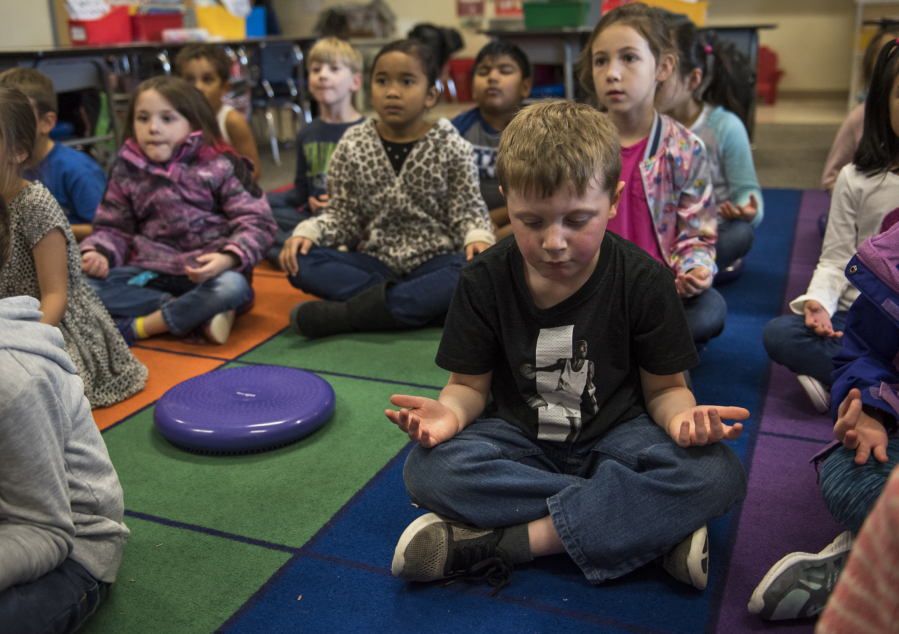As his classmates watched, first-grader Daniel Demedetsky shook a bottle filled with water and glitter.
“It’s like our minds when you’re getting mad and going all crazy,” Daniel said, watching as the turbulent sparkles swirled around the bottle.
But as students in Katrina Munro’s Illahee Elementary School class watched and breathed slowly, the glitter settled. So too did a calm over the group of first-graders.
This is a brain break in Munro’s class, an opportunity after a high-energy activity like recess to do some deep breathing and reflecting. It’s part of the district’s mindfulness curriculum, implemented last year. The goal, said Carl Smith-Knapp, assistant director of student services for Evergreen Public Schools, is to get students conscious of their thinking and behavior, calm and focused, and less stressed in the classroom.
“It gives them an opportunity to take scheduled breaks throughout the day to rest their brains,” Smith-Knapp said. Smith-Knapp has been the lead instructor on mindfulness in classrooms.
Mindfulness is the hot new trend in education, with districts across the country looping the practice into their day-to-day activities. In Munro’s first-grade class, that means taking a few minutes to do some deep breathing, usually with the help of a visual aid like the glitter jar, or a set of chimes rung once. Middle and high school students have higher-level conversations about the subject, talking about the parts of the brain that are affected with mindful meditation.
The first-grade class also discusses what kind of activities are mindful, noting them on a poster in the classroom. Raising one’s hand and waiting patiently to be called on, for example, is mindful of your classmates’ and teacher’s time. Following the teacher around and tapping on her to get her attention? Not so much.
“We talk a lot about what does that look like, what does that sound like, what does that feel like,” Munro said.
It’s too early to say for sure whether mindfulness has had a significant impact at Evergreen Public Schools campuses. The district has been practicing mindfulness in classroom for two years.
But a growing body of research suggests that mindfulness can make positive impacts on elementary- and secondary-age students. According to Mindful Schools, a California-based organization training educators on how to incorporate mindfulness into their routines, mindfulness can help improve students’ behavior in schools, reduce stress and depression, and even lead to improved grades.
“Studies have indicated mindfulness has improved things like student attention, emotional regulation, behavior in schools, their empathy and understanding of others, their social skill development,” Smith-Knapp said. “It also addresses the test anxiety and stress management.”
The ultimate marks of success will come when students, after practicing mindfulness for several years, have graduated. Smith-Knapp hopes the district will see higher graduation rates, as well as decreased teacher turnover, as a result of the program.
“All of those things add up to kids wanting to be in school where they can practice those things to the benefit of themselves and others,” Smith-Knapp said.
As the students in Munro’s class wrapped up their brain break, they walked quietly back to their desks, pulling out pencils in anticipation of a math worksheet.
“The kids in general become more focused on new learning or transitions from one content area to the next,” she said.
And that means more time for learning.
“We do our best learning when we feel calm and focused and relaxed and ready to learn,” Munro said.




